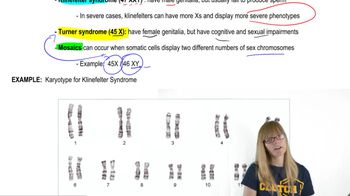- 1. Introduction to Genetics51m
- 2. Mendel's Laws of Inheritance3h 37m
- 3. Extensions to Mendelian Inheritance2h 41m
- 4. Genetic Mapping and Linkage2h 28m
- 5. Genetics of Bacteria and Viruses1h 21m
- 6. Chromosomal Variation1h 48m
- 7. DNA and Chromosome Structure56m
- 8. DNA Replication1h 10m
- 9. Mitosis and Meiosis1h 34m
- 10. Transcription1h 0m
- 11. Translation58m
- 12. Gene Regulation in Prokaryotes1h 19m
- 13. Gene Regulation in Eukaryotes44m
- 14. Genetic Control of Development44m
- 15. Genomes and Genomics1h 50m
- 16. Transposable Elements47m
- 17. Mutation, Repair, and Recombination1h 6m
- 18. Molecular Genetic Tools19m
- 19. Cancer Genetics29m
- 20. Quantitative Genetics1h 26m
- 21. Population Genetics50m
- 22. Evolutionary Genetics29m
In C. elegans there are two sexes: hermaphrodite and male. Sex is determined by the ratio of X chromosomes to haploid sets of autosomes (X/A). An X/A ratio of 1.0 produces a hermaphrodite (XX), and an X/A ratio of 0.5 results in a male (XO). In the 1970s, Jonathan Hodgkin and Sydney Brenner carried out genetic screens to identify mutations in three genes that result in either XX males (tra-1, tra-2) or XO hermaphrodites (her-1). Double-mutant strains were constructed to assess for epistatic interactions between the genes (see table). Propose a genetic model of how the her and tra genes control sex determination.
Genotypeᵃ XX Phenotype XO Phenotype
Wild-type Hermaphrodite Male
tra-1ʳᵉᶜ Male Male
tra-2ʳᵉᶜ Male Male
her-1ʳᵉᶜ Hermaphrodite Hermaphrodite
tra-1ᵈᵒᵐ/+ Hermaphrodite Hermaphrodite
tra-1ʳᵉᶜ tra-2ʳᵉᶜ Male Male
tra-1ʳᵉᶜ her-1ʳᵉᶜ Male Male
tra-2ʳᵉᶜ her-1ʳᵉᶜ Male Male
tra-2ʳᵉᶜ tra-1ᵈᵒᵐ/+ Hermaphrodite Hermaphrodite
ᵃrec = recessive mutation; dom = dominant mutation.
 Verified Solution
Verified Solution

